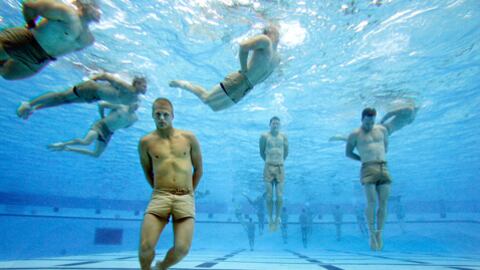They're the nation's quietest killers, known as SEALs because of their delicate work by Sea, Air or Land. But they can also just crash through doors and "double tap" the enemy’s face, as they did with Osama bin Laden this week, killing the ringleader of the September 11th attacks with two point-blank shots. The SEALs were already a semi-legendary unit, the home to gung-ho soldiers who claim to drink snake venom and punctuate their kills with a kiss on the cheek (to take just two examples from the memoirs of former SEALs). Perhaps such braggadocio is inevitable given what it takes to qualify.
Gallery: Navy SEALS: America’s Quietest Killers

SEAL training is two years—the same as astronaut training—and it includes an agonizing combination of brain and brawn work, topped with five days of simulated battle stress. The men call it "Hell Week," a regime of bullets, bombs, and extreme endurance tests. Men can ring a bell to quit at any time, and two out of three do so. Right now there are only about 2,500 SEALs on active duty in a range of missions worldwide, virtually all of them secret. The best of those are invited to join SEAL Team Six, as it's popularly known—the team that picked off three Somali pirates from 100 yards on rough seas. And the team that finally got bin Laden.
ADVERTISEMENT
• The Daily Beast's Complete Osama bin Laden CoverageThe SEALs originated as "frogmen" clearing beaches during World War II, moved on to bridge demolition during Korea, and gained fame (along with the SEAL name) during Vietnam. But the modern SEALs were born in the aftermath of the Iran hostage crisis as a specialized counterterrorism force. The initial results were underwhelming: Four drowned during the invasion of Grenada in 1983, a team failed to save a kidnapped CIA station chief in Beirut in 1985, and by 1987 the whole division was wracked with fraud (including cases of guys stealing scuba equipment). The 1990s were scarcely better, as SEAL units "were never used even once to track down terrorists who had taken American lives," according to a 2004 study by Richard H. Schultz Jr., the director of the International Security Studies Program at Tufts University.
The main reason, he says, was risk-aversion: The Clinton administration didn't want to contemplate another Mogadishu, where more than a dozen Special Ops soldiers were killed in 1993. That calculation held, Schultz argues, even as al Qaeda bombed the World Trade Center, struck two U.S. embassies in East Africa, and tried to sink the USS Cole in Yemen in 2000. After the September 11th attacks, however, the Bush administration began to lean heavily on so-called hunter-killer teams dispatched to kill terrorists abroad. And President Obama has continued to do so-—some say even more so than his predecessor.
The upshot: an estimated 2,000 dead members of al Qaeda, "a significant portion" of them deep-sixed by the SEALs, says Schultz.
Tony Dokoupil is a staff writer and editor at Newsweek.




